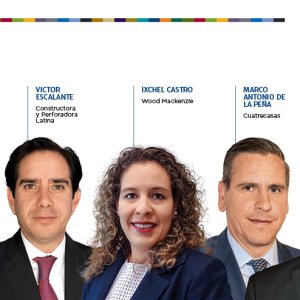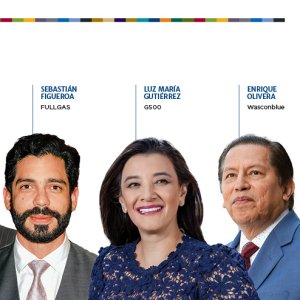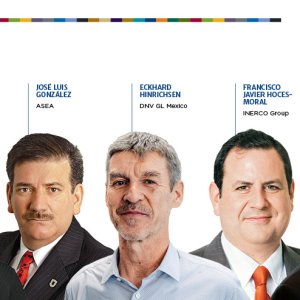
NAICM: Mexico Promise to Open Opportunities
Mexico’s “Door to the World” won’t open for another two years at least, but it promises to usher the country into a new era of prestige. Most pundits agree that despite public skepticism and with presidential elections just around the corner, the new Mexico City International Airport (NAICM) project has not only taken off, it will fly unabated.
“This project is unstoppable as it is so advanced already,” Eduardo Andrade, Director of Sacyr Mexico, said during the first day of the Mexico Infrastructure & Sustainability Summit 2017, held at the Sheraton Maria Isabel hotel in Mexico City on Tuesday. The event continues on Wednesday.
The airport project is led by SCT and Grupo Aeroportuario de la Ciudad de México (GACM). Norman Foster of prestigious international firm Foster + Partners is the master architect, and renowned UK firm ARUP is in charge of the design. Among other partners are Fernando Romero Enterprises and the Netherlands Airport Consultants.
With the current 770ha AICM saturated with passenger traffic, the new airport located 5km northeast of AICM covers a massive 5,000ha. The most ambitious infrastructure project in Mexico, it will be the first airport outside the US with triple simultaneous operations, with three planes able to take off and land at the same time over six runways. “This will be the second-biggest airport in the world after Istanbul,” said Ricardo Dueñas, CFO of GACM.
The first six works have already been completed: the perimeter fence, 48km of access roads, cleaning of the land, temporary drainage, the GACM camp and the moving of debris. Twenty-seven works are under construction, with 292 companies involved and 40,000 direct and indirect employees.
With this scale, not only does the NAICM project have a direct impact on quality of life and employment opportunities for Mexico, it extends beyond just a new airport. “This project goes further than just NAICM,” Dueñas said. “It also opens up opportunities in connection links, such as the metro and new highways that will be necessary, as well as the reuse of the AICM land.” It also has the potential to boost Mexico’s international clout, given no major airports have been built in the region for over two decades. The country “can be a global logistics air hub and NAICM is urgently needed,” Juan Torres Landa, Partner at Hogans Lovells, told the audience.
Panelists during the event identified three key axes for NAICM’s agenda: transparency, sustainability and governance.
The first, transparency, is essential to foster the required investment and gain the approval of the people, some of whom remain skeptical. Alicia Silva, Director and Founder of Revitaliza Consultores, understands that there is a lot of disbelief about how the project is being carried out, given its magnitude. “This project almost seems unreal, but Mexico indeed has a transparent project,” she said.
The OECD has published two reports on NAICM, stressing the importance of corporate governance throughout the project, the second axis. Jacobo García, Senior Specialist in Policies of Integrity and Public Purchasing at OECD, said that “infrastructure is a source of investment and competitiveness for any country.” It is key to focus on the importance of governance of infrastructure projects to plan their strategic execution, as “the megaproject is a conglomerate of projects of such a magnitude that will carry a high-impact social dynamic,” he added.
GACM’s Dueñas said that transparency has been a hallmark of the development. “We are following the best international practices,” he explained, referencing GACM’s collaboration with the OECD and with INAI to promote the greatest level of transparency, both in the bidding rounds and oversight of the project.
Strategic planning through optimum governance will also help secure the continuity of the project, especially as Mexico enters into a presidential election in 2018. “A logistics air hub implies certain complexities,” said Joseph Woodard, Head of Contracts and Procurement at Parsons. The fact that there will be no simultaneity of operations between AICM and NAICM increases the need to comply with construction deadlines, especially since AICM already has a closing date. In this regard, Héctor Ovalle, President of construction firm COCONAL, said, “I can guarantee you will see the second airstrip paved and finished on time.”
Regarding sustainability, the third axis, Silva believes “this is one of those projects in which sustainability works in synergy with the finances.” NAICM’s financial scheme has been internationally awarded the highest ratings for its green bonds. Likewise, “sustainability is being perceived as a reference point on how things are being done well,” and it is a type of metric being used to evaluate the project, she said. Torres Landa agreed: “I believe that it is fundamental to have an environmentally friendly project.”
Financing structures also play a significant role in project viability, and Dueñas explained that NAICM follows a forward-thinking mixed financing scheme, with funds taken both from the government budget (PEF) and private financing. “This is a very viable investment scheme for the government because after debt service is paid, all this profit will go to the public purse,” he said.
Private credit for the project comes from investment banks and bonds, and a flexible scheme with a revolving credit facility. “A few months ago, we raised US$4 billion in the capital markets, equaling a total private financing of US$6 billion,” he said. This amount comes from 750 investors, 45 percent of which are from the US, 21 percent from Asia, 14 percent from Latin America and 20 percent from Europe. “This financing model has won 14 prestigious international prizes.”
Perhaps the new airport’s most significant impact may be on Mexico City’s – and the country’s – competitiveness. “The economy of a city moves at the pace of its transportation network,” said Roberto Calvet, Director General of AECOM, the world’s largest engineering and construction firm that is also involved in the NAICM development. “Three things really impact the economy: a country’s entry and exit points, transit networks within cities and transport routes between different cities and states,” he said.
While not talking specifically about NAICM, José Zozaya, President of railway group Kansas City Southern Mexico (KCSM), hinted at the country’s potential and the importance of thinking internationally. “Considering Mexico’s geographical position, the country should strive to not only be an important regional hub for logistics but a global one.”
A world-class airport would go a long way to facilitating such an ambition.














